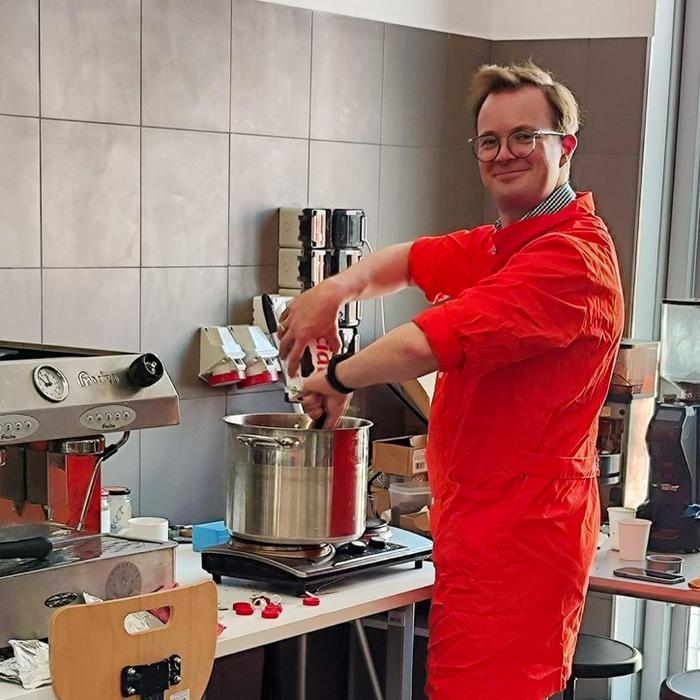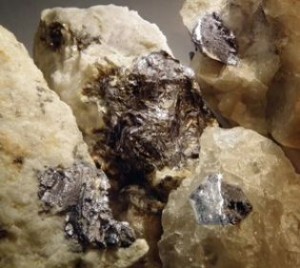
It’s unusual to see a scientist in an orange (maybe it could be called fire engine red?) jumpsuit as it has an altogether different meaning (prison wear) in the US.
Sadly, there isn’t a video of Dr. Maciej Lisicki or other scientists in the kitchen but here’s a description of what they’ve been up to from a June 22, 2023 University of Warsaw (Poland) press release (also on EurekAlert),
Take four brilliant physicists who specialize in fluid mechanics and put them in the kitchen. Give them pots, pans, basic foodstuffs, and a bottle of champagne. Add a COVID-19 pandemic, a pinch of boredom, and a handful of good ideas. Stir, wait, and voilà – you have a “delicious” publication that will teach you how bubbles are created in champagne, how to brew the perfect espresso, and how “kitchen revolutions” can contribute to innovations in many fields, including biomedicine and nanotechnology.
Most of us visit this place every day. But the kitchen is not just for cooking meals. “It can be an excellent place to conduct experiments and even make scientific discoveries,” argues Maciej Lisicki, of the Faculty of Physics of the University of Warsaw, co-author of a publication in the prestigious journal Reviews of Modern Physics. The team of researchers, which in addition to Maciej Lisicki includes Arnold Mathijssen of the University of Pennsylvania, Endre J.L. Mossige of the University of Oslo and Vivek N. Prakash of the University of Miami, not only explores the history of food science, but also shows how phenomena in the kitchen lead to innovations in biomedicine and nanotechnology.
COVID pandemic and bubbles in champagne
Maciej Lisicki and his fellow researchers began working on the article during the COVID-19 pandemic, when many researchers could not work in the lab and began experimenting in their homes. “It started primarily with the intention to make an educational tool, given that kitchens offer a low barrier of entry to doing science — all you need are some pots, pans, and a few ingredients to get a few reactions going—but it quickly grew into a more scientific reflection of the history of food once we realized how interwoven the fields are,” says Arnold Mathijssen.
The team of researchers constructed the results of their work along the lines of a menu. “Tasting” begins with the physics of drinks and cocktails, then moves on to main courses, and finishes with coffee and desserts, whose preparation is also based on the intuitive use of the laws of nature.
As with any good party, everything begins with the opening of a bottle of champagne. After a characteristic “pop”, we observe how a mist forms around the neck of the bottle. – This phenomenon is associated with a rapid change in pressure. Inside the bottle it reaches almost five atmospheres, but when the bottle is opened it drops to one atmosphere. “The expansion is accompanied by a drop in temperature, which causes the water vapor that accumulates near the mouth of the bottle to freeze, and the carbon dioxide coming out of the bottle to condense”, Maciej Lisicki explains.
In their paper, the researchers also look at bubbles, which give sparkling wines their unique flavor. “Circulating bubbles force the transport of the liquid in the glass, and thus facilitate the release and spread of aromatic notes and flavors”, the researcher adds. From the section of the paper devoted to drinks and cocktails, we will also learn what makes the foam in beer so thick and stable, why aniseed drinks such as rakija and ouzo get cloudy when enough water is added (the phenomenon is even called the “ouzo effect”), and what “tears of wine” are.
When water surfs the pan
Moving on to the main course, the scientists explain the role of heat and its effect on food textures, aromas, and flavors. Among other things, they describe the Leidenfrost effect, in which a drop of liquid placed on a very hot surface forms an insulating layer of vapor, that prevents rapid boiling. “Water drops thrown onto the pan ‘surf’ and even bounce off the surface, instead of evaporating immediately”, Lisicki says.
Proper temperature is crucial in the preparation of many foods. “It doesn’t take a Ph.D. in physics to fry the perfect steak. Everyone knows that one needs to quickly sear the meat in a sufficiently hot pan. As a result, the proteins on the surface of the steak coagulate and the moisture is kept inside”, the researcher explains.
A Ph.D. in dishwashing
The text also includes examples of scientific discoveries that researchers have made without leaving their own kitchens. One of them is related to the biography of Agnes Pockels.
“Her story speaks of the inequality in science. She was a woman in Germany in the late 19th century, so she was not allowed to attend university for formal training, making it difficult for her to submit her research to journals,” Mathijssen says.
Running her parents’ household and spending a lot of time in the kitchen, she quickly began experimenting there. “Observing the formation of foam and films on the surface of dirty dishes, she was the first to describe the phenomenon of surface tension and developed an instrument to measure it. Initially, scientific journals were reluctant to publish the results of her experiments due to her lack of formal training and affiliation with university staff. Her first paper was published through Lord Rayleigh in Nature and contributed to the understanding of surface effects in liquids. Agnes Pockels then became well-known and respected, and all her subsequent work was published in high-profile journals. This example shows that it is possible to become a respected scientist without leaving home,” notes Maciej Lisicki.
Salad dressing vs. nanoengineering
Research in fluid mechanics can help improve food processing technologies, as well as find applications in other fields such as nanoengineering and medicine. “In an earlier study (“Rechargeable self-assembled droplet microswimmers driven by surface phase transitions”, published in Nature Physics) conducted by my team, we used a simple emulsion that is the basis of salad dressings – oil with water. We were able to make droplets of such an emulsion, with the addition of a surfactant, form tendrils under temperature and move like bacteria. Such nontoxic, biocompatible microfluidics could be used in the future, for example, to precisely deliver drugs anywhere in our bodies”, Lisicki explains.
The review also highlights the applicability of these technologies in areas such as food safety and quality control. By deploying devices that can detect food-borne pathogens or toxins using principles of fluid dynamics, the scientific community can contribute significantly to public health.
Another key aspect of their review is the potential impact it could have on policy decisions, particularly those related to environmental sustainability and food safety. The authors highlight the significance of science-based policies, for example – referencing the announced EU ban on PFAS non-stick coatings by 2030. Using the scientific understanding offered by studies like these, policy makers can make informed decisions to foster a more sustainable and safer food future.
“Kitchen flows show us that significant scientific problems are available at our fingertips and do not always require space technology to explore them. On the other hand, more than a few cosmic technologies were born from inspiration by everyday phenomena. The kitchen can therefore entertain us, but also teach us – in this case, physics. This is why it is worth a try to unleash your curiosity and experiment!” Lisicki adds.
This research was supported by the United States Department of Agriculture (USDA-NIFA AFRI 2020-67017-30776 and 2020-67015-32330).
Faculty of Physics of the University of Warsaw
Physics and astronomy at the University of Warsaw appeared in 1816 as part of the then Faculty of Philosophy. In 1825, the Astronomical Observatory was established. Currently, the Faculty of Physics at the University of Warsaw consists of the following institutes: Experimental Physics, Theoretical Physics, Geophysics, the Department of Mathematical Methods and the Astronomical Observatory. The research covers almost all areas of modern physics, on scales from quantum to cosmological. The Faculty’s research and teaching staff consists of over 200 academic teachers, 88 of whom are professors. About 1,100 students and over 170 doctoral students study at the Faculty of Physics at the University of Warsaw.
Perhaps the paper provides more information about the ice cream research depicted in the visual image at the top of this posting. Here’s a link to and a citation for the paper,
Culinary fluid mechanics and other currents in food science by Arnold J. T. M. Mathijssen, Maciej Lisicki, Vivek N. Prakash, and Endre J. L. Mossige. Rev. Mod. Phys. Vol. 95, Iss. 2 — April – June 2023 025004 DOI: https://doi.org/10.1103/RevModPhys.95.025004 Published: 5 June 2023 © 2023 American Physical Society
This paper is behind a paywall.
